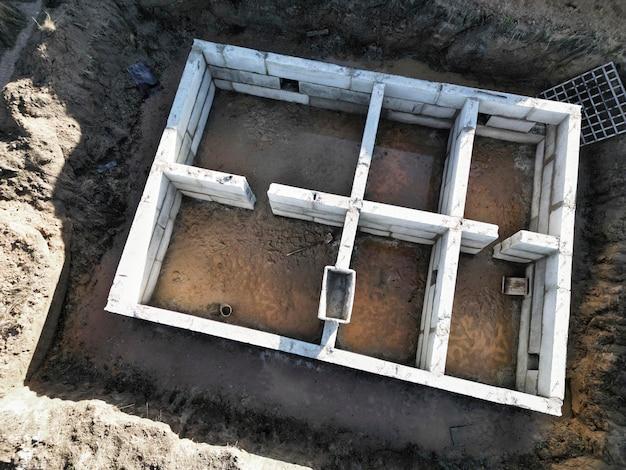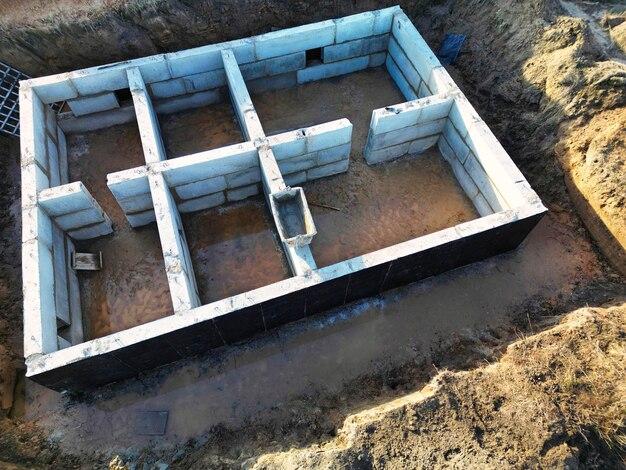Are you considering building a septic tank using concrete blocks? Look no further! In this comprehensive guide, we will walk you through the process of constructing a septic tank using concrete blocks, step by step.
From understanding the required size and dimensions of the tank to knowing how to reinforce the structure with rebar, we’ll cover all the important aspects. We’ll also address common questions like whether septic tanks can be above ground and provide alternatives to traditional septic systems.
So, if you’re looking for a cost-effective and reliable solution for managing your wastewater, follow along as we dive into the world of building septic tanks with concrete blocks. Let’s get started!
How to Build Your Own Septic Tank Using Concrete Blocks
So, you’ve decided it’s time to take matters into your own hands and build your very own septic tank. Well, my friend, you’ve come to the right place. In this guide, we’ll walk you through the steps of how to build a septic tank out of concrete blocks like a true DIY champ. Get ready to dive deep into the world of wastewater management and discover the inner workings of a septic system. But don’t worry, we’ll keep it fun and engaging because who said septic tanks can’t be exciting?
1. Gather Your Tools and Materials
Before you start digging up your backyard like a wannabe archaeologist, make sure you have all the necessary tools and materials at hand. Here’s a checklist to get you started:
Tools
– Shovel for some good old-fashioned dirt-digging.
– Tape measure to ensure your tank is of the perfect proportions.
– Level, because nobody likes a wonky septic tank.
– Rubber mallet for some satisfying block pounding.
– Trowel to spread that concrete mix like a pro.
– Safety gear, including gloves and goggles, because safety is no joke.
Materials
– Concrete blocks, the superhero of today’s adventure.
– Rebar for reinforcement because safety first!
– Concrete mix, the building blocks of your septic kingdom.
– Perforated PVC pipes to channelize the wastewater.
– Gravel for a solid foundation (pun intended).
– PVC couplings and adhesive to connect the pipes.
– Building permit, because legalities matter, folks.
2. Plan Your Layout Like a Boss
It’s time to put on your architect hat and decide where your septic tank will proudly reside in your backyard. Consider factors such as distance from your home, local regulations, and a spot that won’t disrupt future landscaping endeavors. Take measurements and mark the layout using stakes and string. Make sure to call your local utilities to avoid any unexpected surprises while digging.
3. Digging Time—Let’s Get Dirty
Grab that trusty shovel and start digging! It’s like a treasure hunt, but instead of gold, you’ll find satisfaction in creating your own waste management system. Dig a hole according to your planned layout, ensuring appropriate depth and size as per local regulations or guidelines. If you encounter rocky or uneven terrain along the way, just channel your inner adventurer and power through.
4. Lay the Foundation with Gravel
Now that you’ve dug your way into the earth, it’s time to create a solid foundation for your septic tank. Spread a layer of gravel at the bottom of the hole to provide proper drainage and stability. Make sure the gravel is evenly distributed and compacted.
5. Assemble the Blocks—It’s Like Adult LEGO
Ah, the moment you’ve been waiting for—building with concrete blocks. Lay the first layer of blocks, ensuring they fit snugly and form a solid base for your septic tank. Use a level to keep everything nice and straight. Now, create subsequent layers, staggering the blocks to add stability and strength. It’s like playing a giant game of adult LEGO, but with more responsibility.
6. Reinforce and Seal the Cracks
To add some extra muscle to your tank, insert rebar into the hollow cores of the concrete blocks. This will reinforce the structure and hold everything together. Once you’re done with the rebar, it’s time to fill in any gaps and cracks between the blocks. Use mortar or concrete mix to seal them tight. Remember, no cracks allowed in this water-tight fortress!
7. Install the Perforated Pipes—The Maze of Plumbing
Now comes the fun part—plumbing. Lay the perforated PVC pipes across the top of the blocks, ensuring even distribution. These pipes will carry the wastewater away and into nature’s loving embrace. Connect the pipes using PVC couplings and adhesive, creating a maze-like network that will make your plumber friends jealous.
8. Cover It Up—Your Tank Needs a Hat
Your septic tank is almost complete, my friend. But before you go celebrating prematurely, cover it up with a concrete lid. This will not only protect your tank but also keep unwanted critters and odors at bay. Use your trowel skills to spread that concrete mix and create a sturdy lid worthy of your DIY glory.
9. Backfill and Bid Farewell to Your Hole
Now that your septic tank is looking mighty fine, it’s time to say goodbye to the hole you’ve come to know so well. Backfill the hole with soil from the excavation, ensuring proper compaction as you go. Bid adieu to your construction site and standby, because soon you’ll be treating wastewater like a pro.
Well, there you have it, folks—the guide to building your own septic tank out of concrete blocks. Remember to consult local regulations, seek professional advice if needed, and never be afraid to get your hands dirty. You’re now equipped with the knowledge to tackle this DIY project like a true champion. So go forth, build your septic tank, and unleash your inner wastewater warrior!
FAQs: How to Build a Septic Tank Out of Concrete Blocks
How Big is a 900-Gallon Concrete Septic Tank
A 900-gallon concrete septic tank typically measures around 6 feet in length, 6 feet in width, and 5 feet in height. It provides ample capacity for a small to medium-sized household, accommodating their wastewater needs efficiently.
How Deep are Drain Fields Buried
Drain fields, also known as leach fields, are buried at a depth of about 2 to 3 feet below the ground surface. This allows for proper filtration and treatment of the effluent as it seeps into the surrounding soil.
What Should be the Size of Septic Tank
The size of a septic tank is primarily determined by the number of bedrooms in a house. For a smaller residence, a 900-gallon septic tank is usually sufficient. However, larger households may require tanks with capacities of 1,000 gallons or more.
How Thick are the Walls of a Concrete Septic Tank
The walls of a concrete septic tank are typically constructed to be 2 inches thick. This thickness ensures the tank’s durability and strength, allowing it to withstand the weight of the earth and any external pressures.
What are the Dimensions of a 1,000-Gallon Concrete Septic Tank
A 1,000-gallon concrete septic tank commonly measures approximately 8 feet in length, 6 feet in width, and 5.5 feet in height. This size is suitable for medium-sized households, ensuring efficient containment and treatment of wastewater.
What is the Maximum Depth of a Septic Tank
The maximum depth of a septic tank depends on various factors, such as regional regulations and soil conditions. However, most septic tanks are buried at a depth of about 4 to 6 feet to allow for proper functioning and proper access during maintenance.
How Much Does a Concrete Septic Tank Lid Weigh
On average, a concrete septic tank lid weighs around 150 to 200 pounds. The weight may vary depending on the dimensions and thickness of the lid. It’s essential to handle the lid with care during installation and maintenance to avoid any accidents.
How Thick is the Top of a Concrete Septic Tank
The top of a concrete septic tank, also known as the cover, is typically constructed to be 3 inches thick. This thickness provides the necessary strength and durability to support the weight of the soil and any potential surface loads.
Can Septic Tanks be Above Ground
While it’s more common to have septic tanks buried underground, there are instances where above-ground installation may be necessary or preferred. However, building codes and regulations vary, so it’s essential to consult local authorities and professionals to ensure compliance and proper functioning.
What are the Dimensions of a 2,000-Gallon Concrete Septic Tank
A 2,000-gallon concrete septic tank usually has dimensions of approximately 10 feet in length, 6 feet in width, and 6 feet in height. This larger capacity is suitable for larger households or commercial properties that generate more wastewater.
Can You Build a Septic Tank with Concrete Blocks
Yes, it is possible to construct a septic tank with concrete blocks. However, it requires careful planning, proper reinforcement, and precise construction techniques. It’s essential to follow local building codes and guidelines to ensure the tank’s structural integrity and long-term functionality.
Are Concrete Septic Tanks Reinforced with Rebar
Yes, concrete septic tanks are commonly reinforced with rebar (reinforcing bar) to enhance their strength and stability. The rebar is strategically placed within the concrete structure to provide additional support and prevent cracking or collapse.
How Big is a Concrete Septic Tank
Concrete septic tanks come in various sizes to accommodate different wastewater volumes. The smallest tanks, often suitable for smaller households, can range from 500 to 900 gallons. Larger tanks can have capacities of 1,000 gallons or more, ensuring adequate storage and treatment of wastewater.
How Big is the Lid on a 1,000-Gallon Septic Tank
On average, the lid of a 1,000-gallon septic tank measures about 4 feet in length and 3 feet in width. This size allows for sufficient access to the tank during maintenance and inspection, making it easier for professionals to carry out their work.
Can a Septic Tank be Too Big
While there isn’t an exact upper limit to the size of a septic tank, it’s important to consider the wastewater generation of the property to avoid building an excessively large tank. Oversized tanks may not retain the necessary water levels for effective treatment, potentially leading to system issues.
What are the Dimensions of a 500-Gallon Concrete Septic Tank
A 500-gallon concrete septic tank typically measures roughly 6 feet in length, 4 feet in width, and 4.5 feet in height. This smaller tank size is suitable for properties with lower wastewater generation, such as small cabins or cottages.
What are the Alternatives to Septic Tanks
In addition to septic tanks, alternative wastewater treatment systems include aerobic systems, mound systems, and composting toilets. These alternatives cater to specific needs and site conditions, providing viable options for properties where septic tanks are not feasible or desired.
How Do You Build a Septic Drain Field
Building a septic drain field requires careful planning and adherence to guidelines. The general steps include determining the drain field area, excavating the soil, installing perforated pipes, backfilling with gravel, and covering the area with topsoil. It’s crucial to follow local regulations and consult professionals to ensure proper design and installation.
Can You Have a Septic Tank Without a Leach Field
While leach fields are a typical component of traditional septic systems, alternative systems such as mound systems or aerobic systems may not require a conventional leach field. These systems provide different mechanisms for treating and disposing of effluent, allowing for flexibility in site requirements.
Now you’re armed with essential knowledge about building a septic tank out of concrete blocks. So, whether you’re planning a DIY project or seeking insights before consulting professionals, you’re ready to tackle the task with confidence. Remember to check local regulations, seek expert advice, and embrace the humor amidst the dirt; building a septic tank doesn’t have to be a messy experience!

